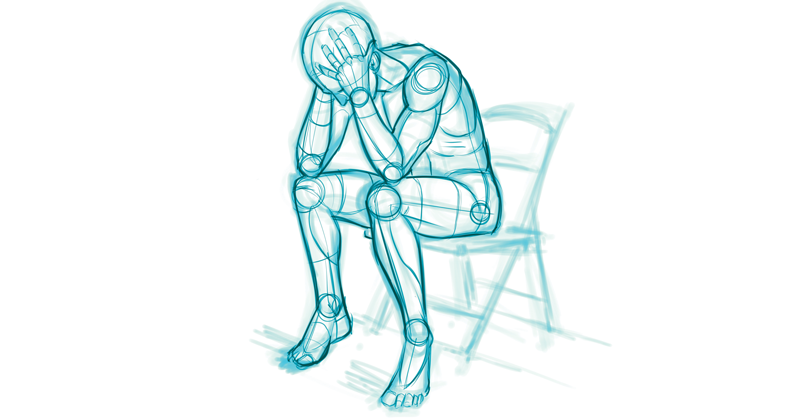5 Jan 2021
Burnout is known for its impact on individuals, but it can also significantly influence business success – affecting client satisfaction, care quality and staff retention. Here Mark Turner, with RCVS Knowledge, sets out simple strategies managers can use to tackle this issue…

Image © pikselstock / Adobe Stock

A 2020 survey found that the rate of burnout among North American vets was higher than that for doctors1 – a stark statistic given the well-documented emotional burden of treating people. But what is burnout?
While the word has traditionally been used to describe a sense of chronic exhaustion2, researchers now have a much better understanding of the subject.
Before we proceed, however, we should challenge a common myth3: in an edition of the BBC Radio 4 programme All in the Mind, professor of occupational health psychology Gail Kinman was asked if a way existed of predicting who might suffer from the condition in the medical profession. In short, she replied: “It can be anybody4.” So, burnout is not a sign of weakness. In fact, burnout is now being reframed as a problem that significantly influences business success – affecting client satisfaction, care quality and staff retention5. So, how should we define it?
Herbert Freudenberger was among the first academics to use the term. Studying the volunteers at a busy centre for drug addicts in New York City in the 1970s, he said that because of the demands of the role, over time team members started to exhibit fatigue, malaise and frustration6,7.
Burnout can be thought of as a combination of three physical and emotional states:
Christina Maslach of the University of California argues that, in particular, the nature of work in the caring professions means that employees who do “people work” are at an additional risk8.
The syndrome is not inevitable, however. In one study, researchers investigated the so-called “job demands-resources” model of burnout9. They were interested in the underlying causes of the phenomenon and proposed that burnout was seen wherever an imbalance between two fundamental aspects of our work lives could be noted:
Their results were clear: employees – irrespective of profession – are more prone to burning out when demands outweigh resources9.
Interestingly, researchers have also found that two aspects of burnout affect employees’ attitude to their job: depersonalisation is associated with lower levels of commitment and exhaustion is associated with a desire to leave the position10.
In summary, while intrinsic (or personal) factors can influence someone’s susceptibility to burn out, the syndrome is, to a much greater extent, determined by organisational factors5,9-11.
| Table 1. The job demands-resources model of burnout (from Demerouti et al9). Burnout can be conceptualised as an imbalance between these two groups of work factors. | |
|---|---|
| Job demands | Job resources |
| Physical workload, time pressure, poor physical environment, recipient (client contact), shift work, role ambiguity | Feedback, job rewards, job control (autonomy), supervisor support, job security, participation (in decision-making). |
| Increased risk of burnout ← | |
Interestingly, research also suggests a relationship between patient safety culture and burnout. A patient safety culture can be defined as a set of beliefs, values and behaviours shared by everyone in the organisation who helps to maintain safety in the face of persistent threats to reliability12.
In one study, the existence of a safety culture was linked to lower rates of burnout and an increased ability among staff to cope with stressful situations12. While it is difficult to know the exact mechanism by which this relationship is mediated, it is interesting to note how very similar a patient safety culture is to elements of the demands-resources model (Table 1) that protect against staff burnout.
For example, patient safety experts recommend that in an effort to minimise the chances of an accident, and to encourage open conversations about mistakes, workloads should be reasonable, but not excessive13; clinical teams should participate in solving problems at the front line of care delivery12; and managerial practices should be based on trust and open communication14.
And at the centre of this culture of patient safety is the routine use of tools that facilitate quality improvement (QI)12 – clinical audits and significant event audits are a framework for driving progress in clinical care. You can find out much more about QI and how to perform a clinical audit or significant event audit on RCVS Knowledge’s QI pages15.
Evidence is growing of the effects of burnout on patient safety as well: one review of the medical literature found that, of 30 studies investigating the link between burnout and patient safety, 21 established a significant association – that is, burned out clinicians were more likely to make errors16.
Burnout appears to affect the productivity of clinicians as well – as burnout takes its toll, so doctors’ professional work effort diminishes11. Given that burnout also affects staff turnover10, the cost to businesses of this syndrome, therefore, is likely to be the sum of reduced productivity, increased recruitment expenditure and managing the effects of lower care quality.
As we have said, researchers have investigated several aspects of burnout. Perhaps, most intriguing is the work that has been done into potential solutions, though: the frequency of burnout in any job can be significantly reduced by taking steps to address workplace factors11. While this sounds like an onerous task, the literature suggests at least nine evidence-based strategies exist to enrich the experience of employees5.
In addition, Shanafelt and Noseworthy5 have said: “Two pervasive myths have been barriers to organisations taking effective action. The first… is that the steps necessary to cultivate physician well-being will conflict with other organisational objectives. The second is the assumption that all effective interventions to reduce burnout will be cost-prohibitive. The reality is that… many effective interventions are cost-neutral.”

According to one study, one in seven young vets will experience burnout within 10 years of graduating22. Alarming reports such as this have generated a healthy debate within the profession about mental health and well-being. Perhaps less well documented in our profession, however, is the evidence base that argues for employer involvement, and if we view burnout essentially as a work-related health issue, its remedy comes into even sharper focus.
Of course, as a variable in the manifestation of the condition, workload is a contentious issue here – particularly in an industry where workflows are uneven by nature – but the research suggests that burnout really can be mitigated by the use of initiatives to help staff. These include the ability to provide feedback to the organisation, revisiting the practice’s culture and thinking about staff workload – a philosophy recently endorsed by the BVA in its “Good Veterinary Workplaces” policy document23.
While burnout has traditionally been seen as an almost inevitable part of life for veterinary professionals, new research suggests that we should actually view it as a “triple whammy” issue – affecting personal well-being, business health and client satisfaction. Employing a strategy aimed at supporting staff then becomes a way not just of acting with compassion, but of boosting revenues and improving service quality.
For free resources to help to tackle team burnout, visit rcvsknowledge.org/quality-improvement